Saturday, March 29, 2014
Acoustic Spaces
The following project is an all-purpose lecture hall for The Southern California Institute of Architecture by Hodgetts + Fung. The architects used a low cost, unique solution in the form of industrial wool felt in order to achieve an acoustic rating of .4 coefficient in the space. The wool felt is meant to deflect and refract the sound for acoustic clarity as the space is used for various lectures etc. in which the school needs sound to travel far back into the space. Named XSS-Experimental
Sound SurfaceCeiling by its inventors, the space resembles upside-down topography, the swells of which help to diffuse the sound in the space.
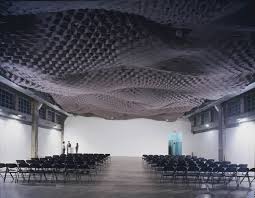
Acoustics
The acoustics of a space are characterized by the interaction between sound and a room, either by absorption, reflection, or diffraction by the walls.
Acoustic absorption refers to a material, structure or object absorbing sound energy when sound waves collide with it, as opposed to reflecting the energy. Reflection, on the other hand, is the change in direction of a wavefront at an interface between two different media so that the wavefront returns into the medium from which it originated. Finally, diffraction refers to various phenomena which occur when a wave encounters an obstacle or a slit. It is the apparent bending of waves around small obstacles and the spreading out of wabes past small openings.
Acoustic metamaterials are artificially fabricated materials designed to control, direct, and manipulate sound waves as these might occur in gases, liquids, and solids. The science of building acoustics analyzes noise transmission from building exterior envelope to interior and vice versa. The main noise paths are roofs, eaves, walls, windows, door and penetrations.
The science of controlling a room’s surfaces based on sound absorbing and reflecting properties is called interior space acoustics. Reflective surfaces can be angled and coordinated to provide good coverage of sound for a listener in a concert hall or music recital space. Ideal acoustical panels are those without a face or finish material that interferes with the acoustical infill or substrate. Fabric covered panels are one way to heighten acoustical absorption, as well as perforated metal. Finish material is used to cover over the acoustical substrate, this usually consists of fabric, wood, or acoustical tile.
The three main ways to improve workplace acoustics and solve workplace sound problems is by absorbing, blocking, and covering up.
The Jay Pritzker Pavilion designed by Frank Gehry in Millenium Park in Chicago, is one of my favorite projects involving acoustically designed architecture. The venue has a system that effectively produces an even quality of sound throughout the entire venue. It has received critical acclaim for its technological adaptations, such as signal processing.
The overall acoustic system is a distributed sound reinforcement system, which allows musicians on stage to hear each other clearly in a way that facilitates ensemble play. In addition, direct natural sound from the stage is reflected from architectural surfaces as well as being reinforced by two sound systems. Distributed speakers allow for lower sound bolumes than would be necessary with centralized speakers.
In addition, I recently visited Carnegie Hall and admired the overall spherical shape of the interior hall in which the performances took place. This shape made the sound travel from the performer to every member in the audience, regardless of where they were sitting.
Acoustic absorption refers to a material, structure or object absorbing sound energy when sound waves collide with it, as opposed to reflecting the energy. Reflection, on the other hand, is the change in direction of a wavefront at an interface between two different media so that the wavefront returns into the medium from which it originated. Finally, diffraction refers to various phenomena which occur when a wave encounters an obstacle or a slit. It is the apparent bending of waves around small obstacles and the spreading out of wabes past small openings.
Acoustic metamaterials are artificially fabricated materials designed to control, direct, and manipulate sound waves as these might occur in gases, liquids, and solids. The science of building acoustics analyzes noise transmission from building exterior envelope to interior and vice versa. The main noise paths are roofs, eaves, walls, windows, door and penetrations.
The science of controlling a room’s surfaces based on sound absorbing and reflecting properties is called interior space acoustics. Reflective surfaces can be angled and coordinated to provide good coverage of sound for a listener in a concert hall or music recital space. Ideal acoustical panels are those without a face or finish material that interferes with the acoustical infill or substrate. Fabric covered panels are one way to heighten acoustical absorption, as well as perforated metal. Finish material is used to cover over the acoustical substrate, this usually consists of fabric, wood, or acoustical tile.
The three main ways to improve workplace acoustics and solve workplace sound problems is by absorbing, blocking, and covering up.
Modal Theory
Geometric Theory
For rooms of high volume or with a complex
geometry, the theory of acoustical geometry is critical and can be applied. The
waves are modelised with rays carrying acoustical energy. This energy decrease
with the reflection of the rays on the walls of the room. The reason of this
phenomenon is the absorption of the walls.
The problem is this theory needs a very high
power of calculation and that is why the theory of Sabine is often chosen
because it is easier.
Sabine Theory
The Jay Pritzker Pavilion designed by Frank Gehry in Millenium Park in Chicago, is one of my favorite projects involving acoustically designed architecture. The venue has a system that effectively produces an even quality of sound throughout the entire venue. It has received critical acclaim for its technological adaptations, such as signal processing.
The overall acoustic system is a distributed sound reinforcement system, which allows musicians on stage to hear each other clearly in a way that facilitates ensemble play. In addition, direct natural sound from the stage is reflected from architectural surfaces as well as being reinforced by two sound systems. Distributed speakers allow for lower sound bolumes than would be necessary with centralized speakers.
In addition, I recently visited Carnegie Hall and admired the overall spherical shape of the interior hall in which the performances took place. This shape made the sound travel from the performer to every member in the audience, regardless of where they were sitting.
Keith Yeung: Acoustics Research
Acoustics has many way of affecting human perception. In many ways the sound that bounces back form a surface can create a spatial feeling of depth. Depending on the shapes of the surfaces and the directions it points, the sound quality could could enhance the music at the concert hall or redirect loud noises away from the peaceful space.
Depending on the material of acoustics, the strength of the sound that bounces off will differ. Masonry materials will isolate sound greatly as it is quite thick. Thick materials are rigid enough to absorb and stop sound. However, wood is much denser than masonry thus absorbing less sound. However, it is more effective in resonating sound more easily and giving more control to the sound reflected. Physically theaters are designed to have short reverberation time (or reflections) so the less sound waves hit objects the longer it lasts. Theaters are designed to reflect the sounds coming from the stage, increasing the amount waves and absorbing excess sound.
Architects Design the volume that holds these acoustic. The angle to which these volume are designed can greatly affect the way sound is absorbed by the audience. Determining the angles of the reflection of sound can effect the comfort of the audience. The architects at the image below uses the relation of the human projection to calculate the distance and reflections of the sounds created.
Friday, March 28, 2014
Eugene Jahng: Acoustic Research
Sound in its simplest form is a vibration, a wave that is transmitted through a media. In an area specifically constructed for sound, such as theaters or concert halls, it is significant to consider every aspect of how sound is reflected and absorbed, as well as the directions of acoustic transmission. The endurance of sound in an area and its remnants or echoes from the original source is referred to as reverberation.
Reverberation times, the amount of time it takes for the sound to completely dissolve, is a crucial factor in designing architecture acoustics, as the area must achieve a certain reverberation time in order to result in the best display of sound. Reverberation time must be perfectly controlled within spaces, as too much of it could result in excessive echoes and a difficult deciphering of sound, while too little of it would not be able to reach all corners of the space. Through surfaces that adequately reflect and absorb sound, the optimal reverberation time can be created.
The interior walls of an area should be angled for direct and controlled reflection of sound. For sound to reach rear corners of the space, the reflectivity and direction of the interior walls should be carefully considered. The materials in which interior walls are made of are important as well. Fabric or perforated metals are capable of absorbing sound, and the panels that construct the interior wall should have finishes that will not interfere with the absorption such as wood, fabric, or acoustical tiles.
Frank Gehry's Walt Disney Concert Hall is a unique design of a concert hall where the or hear and the audience are seated in the same space. The overall architectural elements of the hall such as the partitions and the curved ceilings are all thoroughly involved in an intricate acoustical system.
http://www.archdaily.com/441358/ad-classics-walt-disney-concert-hall-frank-gehry/
Reverberation times, the amount of time it takes for the sound to completely dissolve, is a crucial factor in designing architecture acoustics, as the area must achieve a certain reverberation time in order to result in the best display of sound. Reverberation time must be perfectly controlled within spaces, as too much of it could result in excessive echoes and a difficult deciphering of sound, while too little of it would not be able to reach all corners of the space. Through surfaces that adequately reflect and absorb sound, the optimal reverberation time can be created.
The interior walls of an area should be angled for direct and controlled reflection of sound. For sound to reach rear corners of the space, the reflectivity and direction of the interior walls should be carefully considered. The materials in which interior walls are made of are important as well. Fabric or perforated metals are capable of absorbing sound, and the panels that construct the interior wall should have finishes that will not interfere with the absorption such as wood, fabric, or acoustical tiles.
Frank Gehry's Walt Disney Concert Hall is a unique design of a concert hall where the or hear and the audience are seated in the same space. The overall architectural elements of the hall such as the partitions and the curved ceilings are all thoroughly involved in an intricate acoustical system.
http://www.archdaily.com/441358/ad-classics-walt-disney-concert-hall-frank-gehry/
Assignment 5: Acoustics Research
The way sound travels in the enclosed space relates to the dispersion of the sound waves. This dispersion of waves, unless controlled, excessively amplifies sound or creates unwanted echoes. The general solution to avoid such a problem is avoiding the use of reflective surfaces in the space on a large scale. A great example of acoustic architecture is the MIT Chapel by Saarinen. The outside form of the chapel is a simple, continuous cylindrical brick structure, supported by a series of low arches.

On the inside this cylindrical structure is offset and doubled with a slight modification- the interior walls are undulating brick.

The surface that the brick pattern creates is perfect for achieving the ideal reverberation in that intimate interior space. One can actually experience the slight echo if he or she speaks, standing in the center of the room. The double width of the walls not only insulates the interior from the noise outside it, but also allows the interior space to become a space where sound waves emitted from the altar space are amplified just enough to be heard well throughout the interior space. The ceiling is also a 3d surface, made out of a plaster like material that allows the ceiling to contribute to the reverberation of sound.
"Saarinen stated that "since it [the chapel] is built largely of masonry, it should sound that way." However, Saarinen did allow for music and speech to be heard clearly. When the chapel is empty, the reverberation time at 500 cps is about 300 seconds. With an audience of 115 people, the reverberation time is only about 1.8 seconds. The hard plaster ceiling also helps to spread sound with its inverted cone shape. Red brick is used and gray,leaded glass in the narthex. (The chapel’s aluminum bell spire was sculpted by Theodore Roszak.) "
Sources:
http://kubuildingtech.org/sarcweb/Assemblages00/CaseFinals/Lena%20Coleman-Kresge%20Chapel/Eero%20Saarinen-Bio.htmlhttp://www.acoustics101.com/default.asp
Labels:
Acoustics Research,
Assignment 5,
Kharche,
Madhura,
Madhura Kharche
Chang Liu_Lonking Out Week 8
House Pedralbes / BCarquitectos
This family home
is located in the upper area of Barcelona. The project proposed to move the
building to the rear of the site in order to achieve the best orientation
towards the south and east, and to have a spacious garden. Furthermore,
building the house on the highest point of the land attains the best views of
the sea, the city of Barcelona and also the Serra de Collserola. Its proximity
to a ring road required a formal solution to noise pollution. Estudio BC
resolved this in the home, by designing a wooden skin formed by vertical slats, which covers the back and side
façade, and planning a green wall-slope on the edge of the lot that reinforces
the protection against the noise.
The pedestrian access to the house
through the garage is located to the side of the site from the lowest level.
The main entrance is located in the middle part of the first floor. The
different floors, first, second, third and basement are designed following the
longitudinal form of the terrain, with a stairwell and elevator in the middle
that divides the different areas in each level. The basement as well as the garage includes storage rooms, exercise room,
wine cellar and a gym at the back of the garden. The hall divides the space on
the first floor: to the left are the living areas, opposite this the dining
room and to the right the kitchen office and service areas. The bedrooms, along
with a studio and terraces, are on the second floor while the master bedroom is
on the third floor, which is also equipped with terraces.
Chang Liu_Lonking Out Week 7
hernandez
silva arquitectos: house FF, mexico
mexican practice hernandez silva arquitectos have just completed ‘house FF,’ a
private residence located on a cul-de-sac in zapopan, mexico.
a dynamic interplay of forms and materials, the dwelling is rooted in the idea of providing a range of views and varying qualities of space.
formally, the reinforced concrete and steel construction presents a solid white mass resting upon a foundation clad in natural wood veneer to
further accentuate a floating effect. many geometries on the second storey overhang the exterior spaces at ground level providing passive shading
and defining shared buffer spaces. the entrance contains a reflecting pool after passing a lush walkway to the front gate, that sets the tone for the
rest of the design as it defines a sort of mellifluous courtyard that instantly becomes part of the interior space with the sliding of a large glass wall.
a dynamic interplay of forms and materials, the dwelling is rooted in the idea of providing a range of views and varying qualities of space.
formally, the reinforced concrete and steel construction presents a solid white mass resting upon a foundation clad in natural wood veneer to
further accentuate a floating effect. many geometries on the second storey overhang the exterior spaces at ground level providing passive shading
and defining shared buffer spaces. the entrance contains a reflecting pool after passing a lush walkway to the front gate, that sets the tone for the
rest of the design as it defines a sort of mellifluous courtyard that instantly becomes part of the interior space with the sliding of a large glass wall.
the primary social spaces at entry level have no physical
partition between them, each offering a new palette of materials that connect
to one another
with an endless juxtaposition of heavy and light. these areas also bleed out to the exterior through retractable walls and sight lines. a small central
concrete staircase takes the owner to the upper floor where the private bedrooms enjoy the warmth of a wooden floor encased in white, all under a
massive canopy that shades the interior and directs views down the linear corridor into the yard. thin wooden blinds add a new texture to the transparent
facade as it adds a level of privacy towards the street. the yard and terrace demands attention on its own, with a small bar under the cantilevering mass above,
is open to the outside where a swimming pool and the year-round comfortable climate beckon friends and family to spend their time outdoors.
with an endless juxtaposition of heavy and light. these areas also bleed out to the exterior through retractable walls and sight lines. a small central
concrete staircase takes the owner to the upper floor where the private bedrooms enjoy the warmth of a wooden floor encased in white, all under a
massive canopy that shades the interior and directs views down the linear corridor into the yard. thin wooden blinds add a new texture to the transparent
facade as it adds a level of privacy towards the street. the yard and terrace demands attention on its own, with a small bar under the cantilevering mass above,
is open to the outside where a swimming pool and the year-round comfortable climate beckon friends and family to spend their time outdoors.
Chang Liu_ Assignment 5_Acoustics Research
Architectural acoustics can be about achieving good speech intelligibility in a theater, restaurant or railway station, enhancing the quality of music in a concert hall or recording studio, or suppressing noise to make offices and homes more productive and pleasant places to work and live in. Architectural acoustic design is usually done by acoustic consultants.
This science analyzes noise transmission from building exterior envelope to interior and vice versa. The main noise paths are roofs, eaves, walls, windows, door and penetrations. Sufficient control ensures space functionality and is often required based on building use and local municipal codes. An example would be providing a suitable design for a home which is to be constructed close to a high volume roadway, or under the flight path of a major airport, or of the airport itself.
The science of limiting and/or controlling noise transmission from one building space to another to ensure space functionality and speech privacy. The typical sound paths are ceilings, room partitions, acoustic ceiling panels (such as wood dropped ceiling panels), doors, windows, flanking, ducting and other penetrations. Technical solutions depend on the source of the noise and the path of acoustic transmission, for example noise by steps or noise by (air, water) flow vibrations. An example would be providing suitable party wall design in an apartment complex to minimize the mutual disturbance due to noise by residents in adjacent apartments.
This is the science of controlling a room's surfaces based on sound absorbing and reflecting properties. Excessive reverberation time, which can be calculated, can lead to poor speech intelligibility.
Sound reflections create standing waves that produce natural resonances that can be heard as a pleasant sensation or an annoying one.[5] Reflective surfaces can be angled and coordinated to provide good coverage of sound for a listener in a concert hall or music recital space. To illustrate this concept consider the difference between a modern large office meeting room or lecture theater and a traditional classroom with all hard surfaces.
Interior building surfaces can be constructed of many different materials and finishes. Ideal acoustical panels are those without a face or finish material that interferes with the acoustical infill or substrate. Fabric covered panels are one way to heighten acoustical absorption. Perforated metal shows also sound absorbing qualities.[6] Finish material is used to cover over the acoustical substrate. Mineral fiber board, or Micore, is a commonly used acoustical substrate. Finish materials often consist of fabric, wood or acoustical tile. Fabric can be wrapped around substrates to create what is referred to as a "pre-fabricated panel" and often provides good noise absorption if laid onto a wall.
Prefabricated panels are limited to the size of the substrate ranging from 2 by 4 feet (0.61 m × 1.22 m) to 4 by 10 feet (1.2 m × 3.0 m). Fabric retained in a wall-mounted perimeter track system, is referred to as "on-site acoustical wall panels". This is constructed by framing the perimeter track into shape, infilling the acoustical substrate and then stretching and tucking the fabric into the perimeter frame system. On-site wall panels can be constructed to accommodate door frames, baseboard, or any other intrusion. Large panels (generally, greater than 50 square feet (4.6 m2)) can be created on walls and ceilings with this method. Wood finishes can consist of punched or routed slots and provide a natural look to the interior space, although acoustical absorption may not be great.
There are three ways to improve workplace acoustics and solve workplace sound problems – the ABCs.
• A = Absorb (via drapes, carpets, ceiling tiles, etc.)
• B = Block (via panels, walls, floors, ceilings and layout)
• C = Cover-up (via sound masking)
While all three of these are recommended to achieve optimal results, C = Cover-up by increasing background sound produces the most dramatic improvement in speech privacy – with the least disruption and typically the lowest cost.
From Wikipedia
From Wikipedia
Jenny Wong: Acoustics Research
Desirable acoustic properties and its correlation with measurable parameters:
1. Good projection of sound to the rear of the enclosure -> long enough reverberation time.
Reverberation is the collection of reflected sounds from the surfaces in an enclosed space. It is a desirable property to the extent that it helps to overcome the inverse square law dropoff of sound intensity in the enclosure. The inverse square law shows that as sound travels further, the sound twice as far from the source is spread over four times the area, lowering the intensity of sound.
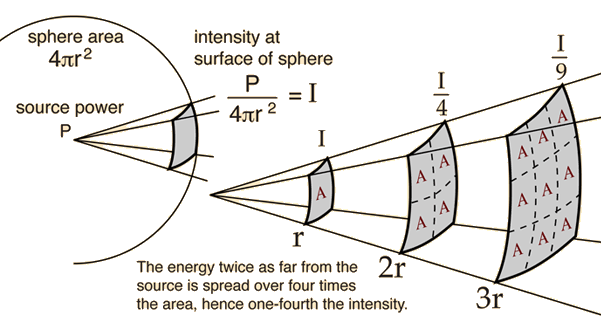
2. Good clarity and articulation -> reverberation time not too long.
The desirable reverberation time is 1.5 to 2.5 seconds. Highly reflective surfaces lengthen the reverberation time while absorbing surfaces shorten the reverberation time. When a sound wave in a room strikes a surface, a fraction of it is absorbed while a fraction is transmitted into the surface. Both of these amounts are lost from the room. The effective absorbing area is a factor in determining the reverberation time of an enclosed space. The absorption coefficient of a surface typically changes with frequency, making the reverberation time frequency dependent. The absorption coefficients of different surface materials can be used to calculation the reverberation time with the Sabine formula.
Absorption coefficient = a
Effective absorbing area = aS


and a is the absorption coefficient associated with a given area S.
3. Good balance of low and high frequencies -> reverberation time for low frequencies longer than for high frequencies.
It is common for distant listeners to experience a deficient in bass. This problem is caused by the characteristic of the ear since the ear shows progressively greater discrimination against low frequencies as the sound gets softer. To solve the problem, we have to design the auditorium so that its reverberation time for low frequencies is greater than that for high frequencies. This can be achieved if a lot of wood is used in the construction since the wood absorbs high frequencies more than lows. However typical thin wood paneling on the suds selectively absorbs low frequencies and thus should be avoided in auditoriums.
The graph shows a progression to higher reverberation times for low frequencies. It is typical for the reverberation time for low frequencies for a good auditorium to be some 30% higher than the overall average reverberation time. This characteristic helps to deal with the bass loss problem, one of the fundamental problems of auditorium acoustics.
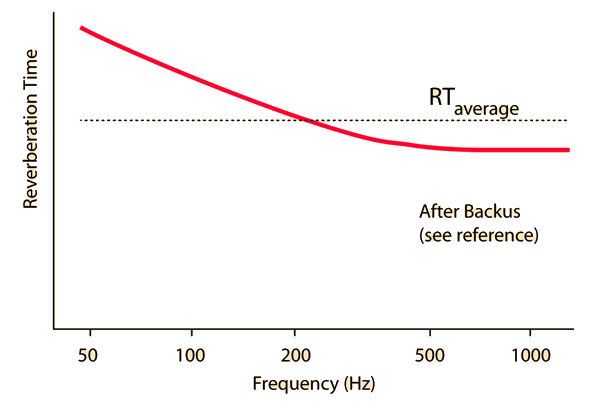
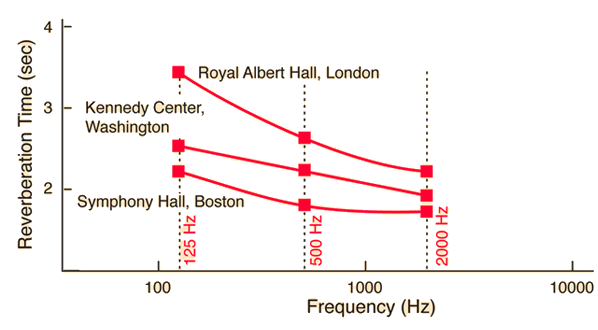
4. Even dispersion of sound. Absence of annoying echoes -> no large reflective surfaces or focusing of sound.
Any time the surfaces of a room focus the sound which is reflected from them, they create spots of high intensity and other spots with low intensity. This is generally undesirable in an auditorium since you want a uniform, evenly dispersed sound to all listeners.
Even large flat reflective surfaces are to be avoided because of the prominent reflection which will be produced. Parallel flat walls can produce a pattern of reflections known as a "flutter echo" as the sound waves travel back and forth between the surfaces. Such flutter echoes are often encountered in highschool gymnasiums where there are parallel side walls and also a reflective floor and ceiling.
Even dispersion is such an important contributor to good acoustics that it is sometimes desirable to use anti-focusing surfaces in a music making area. Older architecture often had columns, decorative sculpture and woodwork, and other dispersing surfaces. In modern architecture with its flat expanses, it is necessary to design in some anti-focusing properties.
Examples of reflective geometries:
Elliptical enclosure
Parabolic Surfaces
Rotunda Effect
Anti-focusing Surfaces
\
5. A feel of "intimacy" or "presence" -> short delay between direct and first reflected sound.
http://hyperphysics.phy-astr.gsu.edu/hbase/acoustic/refdel.html#c1
Source:
http://hyperphysics.phy-astr.gsu.edu/hbase/acoustic/arcaco.html#c1
1. Good projection of sound to the rear of the enclosure -> long enough reverberation time.
Reverberation is the collection of reflected sounds from the surfaces in an enclosed space. It is a desirable property to the extent that it helps to overcome the inverse square law dropoff of sound intensity in the enclosure. The inverse square law shows that as sound travels further, the sound twice as far from the source is spread over four times the area, lowering the intensity of sound.

2. Good clarity and articulation -> reverberation time not too long.
The desirable reverberation time is 1.5 to 2.5 seconds. Highly reflective surfaces lengthen the reverberation time while absorbing surfaces shorten the reverberation time. When a sound wave in a room strikes a surface, a fraction of it is absorbed while a fraction is transmitted into the surface. Both of these amounts are lost from the room. The effective absorbing area is a factor in determining the reverberation time of an enclosed space. The absorption coefficient of a surface typically changes with frequency, making the reverberation time frequency dependent. The absorption coefficients of different surface materials can be used to calculation the reverberation time with the Sabine formula.
Absorption coefficient = a
Effective absorbing area = aS

where V is the volume of the enclosure and

Table of Absorption Coefficients
| Nature of surface | ||||||
| 125 | 250 | 500 | 1000 | 2000 | 4000 | |
| Acoustic tile, rigid mount | 0.2 | 0.4 | 0.7 | 0.8 | 0.6 | 0.4 |
| Acoustic tile, suspended | 0.5 | 0.7 | 0.6 | 0.7 | 0.7 | 0.5 |
| Acoustical plaster | 0.1 | 0.2 | 0.5 | 0.6 | 0.7 | 0.7 |
| Ordinary plaster, on lath | 0.2 | 0.15 | 0.1 | 0.05 | 0.04 | 0.05 |
| Gypsum wallboard, 1/2" on studs | 0.3 | 0.1 | 0.05 | 0.04 | 0.07 | 0.1 |
| Plywood sheet, 1/4" on studs | 0.6 | 0.3 | 0.1 | 0.1 | 0.1 | 0.1 |
| 0.4 | 0.4 | 0.3 | 0.3 | 0.4 | 0.3 | |
| Concrete block, painted | 0.1 | 0.05 | 0.06 | 0.07 | 0.1 | 0.1 |
| Concrete, poured | 0.01 | 0.01 | 0.02 | 0.02 | 0.02 | 0.03 |
| Brick | 0.03 | 0.03 | 0.03 | 0.04 | 0.05 | 0.07 |
| Vinyl tile on concrete | 0.02 | 0.03 | 0.03 | 0.03 | 0.03 | 0.02 |
| Heavy carpet on concrete | 0.02 | 0.06 | 0.15 | 0.4 | 0.6 | 0.6 |
| Heavy carpet on felt backing | 0.1 | 0.3 | 0.4 | 0.5 | 0.6 | 0.7 |
| Platform floor, wooden | 0.4 | 0.3 | 0.2 | 0.2 | 0.15 | 0.1 |
| Ordinary window glass | 0.3 | 0.2 | 0.2 | 0.1 | 0.07 | 0.04 |
| Heavy plate glass | 0.2 | 0.06 | 0.04 | 0.03 | 0.02 | 0.02 |
| Draperies, medium velour | 0.07 | 0.3 | 0.5 | 0.7 | 0.7 | 0.6 |
| 0.2 | 0.4 | 0.6 | 0.7 | 0.6 | 0.6 | |
| Upholstered seating, occupied | 0.4 | 0.6 | 0.8 | 0.9 | 0.9 | 0.9 |
| Wood seating, unoccupied | 0.02 | 0.03 | 0.03 | 0.06 | 0.06 | 0.05 |
| Wooden pews, occupied | 0.4 | 0.4 | 0.7 | 0.7 | 0.8 | 0.7 |
3. Good balance of low and high frequencies -> reverberation time for low frequencies longer than for high frequencies.
It is common for distant listeners to experience a deficient in bass. This problem is caused by the characteristic of the ear since the ear shows progressively greater discrimination against low frequencies as the sound gets softer. To solve the problem, we have to design the auditorium so that its reverberation time for low frequencies is greater than that for high frequencies. This can be achieved if a lot of wood is used in the construction since the wood absorbs high frequencies more than lows. However typical thin wood paneling on the suds selectively absorbs low frequencies and thus should be avoided in auditoriums.
The graph shows a progression to higher reverberation times for low frequencies. It is typical for the reverberation time for low frequencies for a good auditorium to be some 30% higher than the overall average reverberation time. This characteristic helps to deal with the bass loss problem, one of the fundamental problems of auditorium acoustics.

Auditorium Examples
The auditoriums cited below are some of the most outstanding in the world, and they show the consistent pattern of having significantly longer reverberation times for low frequencies.| Symphony Hall, Boston | ||||
| Orchestra Hall, Chicago | ||||
| Severance Hall, Cleveland | ||||
| Carnegie Hall, New York | ||||
| Opera House, San Francisco | ||||
| Arie Crown Theatre, Chicago | ||||
| Royal Festival Hall, London | ||||
| Royal Albert Hall, London | ||||
| Concertgebouw, Amsterdam | ||||
| Kennedy |

Any time the surfaces of a room focus the sound which is reflected from them, they create spots of high intensity and other spots with low intensity. This is generally undesirable in an auditorium since you want a uniform, evenly dispersed sound to all listeners.
Even large flat reflective surfaces are to be avoided because of the prominent reflection which will be produced. Parallel flat walls can produce a pattern of reflections known as a "flutter echo" as the sound waves travel back and forth between the surfaces. Such flutter echoes are often encountered in high
Even dispersion is such an important contributor to good acoustics that it is sometimes desirable to use anti-focusing surfaces in a music making area. Older architecture often had columns, decorative sculpture and woodwork, and other dispersing surfaces. In modern architecture with its flat expanses, it is necessary to design in some anti-focusing properties.
Examples of reflective geometries:
Elliptical enclosure
Parabolic Surfaces
Rotunda Effect
Anti-focusing Surfaces
\
5. A feel of "intimacy" or "presence" -> short delay between direct and first reflected sound.
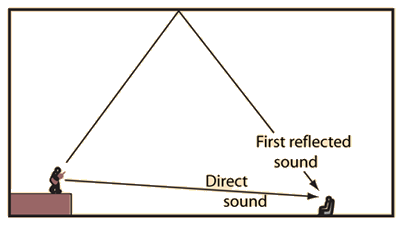 | A large difference between the time of arrival of the direct sound and the first reflected sound is perceived by the listener as a sense of isolation from the performance. Terms used are that the performance lacks "presence" and "intimacy". |
| Comparative | 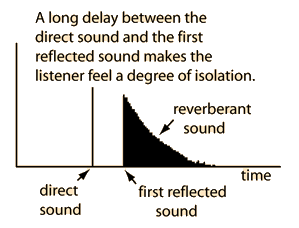 |
Source:
http://hyperphysics.phy-astr.gsu.edu/hbase/acoustic/arcaco.html#c1
Subscribe to:
Posts (Atom)
















